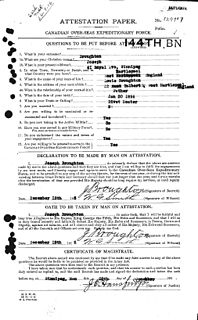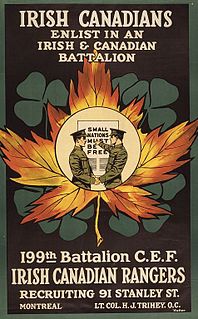Related Research Articles
The 175th Battalion, CEF, was a unit in the Canadian Expeditionary Force during the First World War.
The 177th Battalion, CEF was a unit in the Canadian Expeditionary Force raised during the First World War by the 35th Simcoe Foresters. Based in Barrie, Ontario and later at Camp Borden, the unit began recruiting during the winter of 1915/16 in Simcoe County, Ontario. The battalion arrived at Camp Borden on 3 July 1916 where it trained until sailing to England in May 1917. The battalion was absorbed into the 3rd Reserve Battalion on May 14, 1917. The 177th Battalion, CEF had one Officer Commanding: Lieut-Col. J. B. McPhee, and is perpetuated by The Grey and Simcoe Foresters.
The 206th (Canadien-Francais) Battalion, CEF was a unit in the Canadian Expeditionary Force during the First World War.
The 129th (Wentworth) Battalion, CEF was a unit in the Canadian Expeditionary Force during the First World War. Based in Dundas, Ontario, the unit began recruiting in late 1915 in Wentworth County. After sailing to England in August 1916, the battalion was absorbed into the 123rd and 124th Battalions, CEF and the 12th Reserve Battalion in October 1916. The 129th (Wentworth) Battalion, CEF had one Officer Commanding: Lieut-Col. W. E. S. Knowles.
The 135th (Middlesex) Battalion, CEF was a unit in the Canadian Expeditionary Force during the First World War. Based in London, Ontario, the unit began recruiting in late 1915 in Middlesex County. After sailing to England in August 1916, the battalion was absorbed into the 116th, 125th and 134th Battalions as well as the 8th Reserve Battalion in October 1916. The 135th (Middlesex) Battalion, CEF had one Officer Commanding: Lieut-Col. B. Robson.
The 141st Battalion, CEF was a unit in the Canadian Expeditionary Force during the First World War.

§
The 154th Battalion, CEF was a unit in the Canadian Expeditionary Force during the First World War. Based in Cornwall, Ontario, the unit began recruiting in late 1915 in Stormont, Dundas, and Glengarry Counties. After sailing to England in October 1916, the battalion was absorbed into the 6th Reserve Battalion on January 31, 1917. The 154th Battalion, CEF had one Officer Commanding: Lieutenant-Colonel A. G. F. MacDonald. The Stormont, Dundas and Glengarry Highlanders perpetuate the 154th Battalion.
The 157th Battalion, CEF was a unit in the Canadian Expeditionary Force during the First World War.
The 158th Battalion, CEF was a unit in the Canadian Expeditionary Force during the First World War. Based in Vancouver, British Columbia, the unit began recruiting in late 1915 in that city. After sailing to England in November 1916, the battalion was absorbed into the 1st Reserve Battalion on January 6, 1917. The 158th Battalion, CEF had one Officer Commanding: Lieut-Col. C. Milne.
The 161st (Huron) Battalion, CEF was a unit in the Canadian Expeditionary Force during the First World War. Based in London, Ontario, the unit began recruiting in late 1915 in Huron County. After sailing to England in November 1916, the battalion was absorbed into the 4th Reserve Battalion on February 15, 1918.

The 199th Battalion, CEF was a unit in the Canadian Expeditionary Force (CEF) during the First World War.
The 246th Battalion, CEF was a unit in the Canadian Expeditionary Force during the First World War. Based in Halifax, Nova Scotia, the unit began recruiting in the summer of 1916 throughout the province of Nova Scotia. The unit sent two drafts to England in April and June 1917, both of which were absorbed into the 17th Reserve Battalion, CEF upon arrival. The 246th Battalion, CEF had one Officer Commanding: Lieut-Col. N. H. Parsons.
The 253rd Battalion, CEF, was a unit in the Canadian Expeditionary Force during the First World War. Based in Kingston, Ontario, the unit began recruiting in mid-autumn of 1916, primarily among university students from throughout Canada. After sailing to England in May 1917, the unit was absorbed by the 5th Reserve Battalion, CEF, later that month. The 253rd Battalion, CEF, had one officer commanding: Lieutenant-Colonel P. G. C. Campbell.
The 256th Battalion, CEF was a unit in the Canadian Expeditionary Force during the First World War. Based in Toronto, Ontario, the unit began recruiting in late 1916 in that city. The unit later became the 10th Battalion, Canadian Railway Troops. The battalion received no battle honours and was disbanded on 15 September 1920. The 256th Battalion, CEF had one Officer Commanding: Lieut-Col. W. A. McConnell.
The 109th Battalion CEF was a unit of the Canadian Expeditionary Force, the men of which saw active service during the First World War.

The 46th Battalion, CEF, was an infantry battalion of the Canadian Expeditionary Force during the Great War.

The 104th Battalion, CEF, was an infantry battalion of the Great War Canadian Expeditionary Force. The 104th Battalion was authorized on 22 December 1915 and embarked for Britain on 28 June 1916, where, on 18 July 1916, its personnel were absorbed by the 17th Reserve Battalion, CEF and the 32nd Battalion, CEF, to provide reinforcements for the Canadian Corps in the field. The battalion disbanded on 27 July 1918.
The Otter Commission, or Otter Committee, was established after the First World War to create links of perpetuation from the war-time units of the Canadian Expeditionary Force (CEF) back to the institutionally separate units of the Canadian Militia.
The Grey Regiment was an infantry regiment of the Non-Permanent Active Militia of the Canadian Militia. In 1936, the regiment was Amalgamated with The Simcoe Foresters to form The Grey and Simcoe Foresters.
References
- ↑ Meek, John F. Over the Top! The Canadian Infantry in the First World War. Orangeville, Ont.: The Author, 1971.
- ↑ "Perpetuation of the Units of the Canadian Expeditionary Force (C.E.F.), 1914-1919 Infantry - 231st Infantry Bn to 260th Infantry Bn". The Regimental Rogue. Retrieved 6 November 2019.